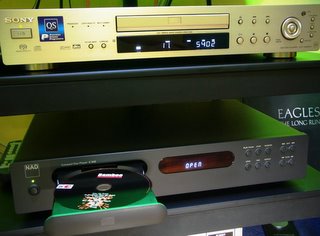
playing the same title in SACD and the redbook CD format, which would you choose?
With Rebecca Pidgeon's The Raven album (Chesky SACD & CD) as the test CDs, both the SACD and CD version were alternatively played for purposes of an A-B comparison of the two formats using Sony DVP-NS915V for the SACD and NAD C542 for the CD. The SACD Player was hooked to Consonance m99+ tube amp using Tara Labs Prism 5 interconnects while the CD Player was linked to the same amp using Ixos 1014 Gamma Audition II Interconnects. The 2 interconnects have the same or similar characteristics being copper-based ICs. The speaker is inconsequential but for the sake of mentioning - it is a pair of Mordaunt-Short 914 floorstander.
The result: The SACD is no good or to put it plainly, it did not exceeded my expectation that it would sound a lot better than a good CD. In fact there were even times when I can say that the CD copy has more bits of resolution than the SACD copy. So, if I were you guys, don't waste your funds trying to appreciate the over-hyped and misplaced superiority of an SACD.
But that's just me.... you might have a better SACD Player.
I had doubts on what I heard so I let my eyes compliment my logic. I opened up the hood of both players and visually compared what's inside and carefully located and identified the critical components like the power transformers, DACs, op-amps, and capacitors since these are the parts that play vital roles in the amplification process or in sound reproduction in general, and here's what I found out:
The CD Player is equipped with a toroidal transformer thrice the size of that of the DVD Player which is so disgustingly tiny and miniscule. Although the DVD Player may boast of having the Sony CDX2753 DSD chip to decode SACDs, the audio circuitry was designed in such a way that the front left and front right channel share only one op-amp, the rear left and the rear right channel also share only one op-amp as well as the center and the LFE out, totaling only three (3) op-amps for the 5.1 channel outputs. On the analog outs, there is another op-amp being shared by the right and left channel in stereo mode. These op-amps are fed to Elna capacitors of so miniscule in size and in value. Compared to the CD Player, it is gifted with Burr Brown PCM 1732 DAC with integrated HDCD Decoder and separate op-amps for the left and right channel with audiophile-grade Nichicon capacitors with values ranging from 1000uF to 6800uF. Looking at the connectors, the CD Player boast of having a pair of gold-plated RCA connectors compared to the tin-plated connectors of the DVD Player.
So, how in the world can these low end DVD Players (like the Sony SACD Player) beat the hell out of the CD Player's capability and potential to make better music even if you play SACDs on these DVD Players? I would have to agree that SACDs may sound a lot better if these are played on high end SACD Players which are prohibitively priced beyond my reach.
I am not an avid fan of multi-channel music for the simple reason that I can hardly appreciate music coming out from 6 different sources. What's so thrilling about listening to the two-channel medium is that it affords the listener the chance to localize the instruments being played through your system's capability to project imaging and visualize ambience through its soundstaging facility. I just can't equate multi-channel music from a real concert performance where the sound emanates only from the fronts unlike with multi-channel systems where sounds may come from different directions.
To each his own maybe?








